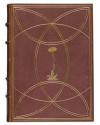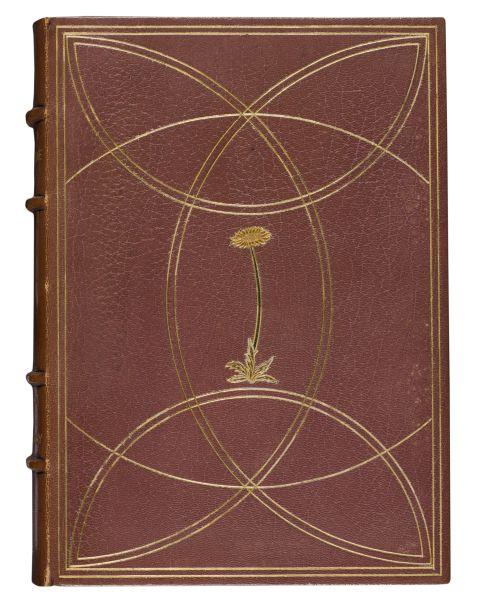Le portrait de Dorian Gray
Artist: Jean-Émile Laboureur (French, 1877-1943)
Publisher: Société d’Édition "Le Livre", Paris, 1928 (Émile Chamontin, director)
Binder: Randeynes & Fils, [s.l.]
Author: Oscar Wilde (Irish | British, 1854-1900)
Date: 1928
Dimensions:
Book: H: 11 3/8 in. (289 mm); W: 8 1/8 in. (206 mm); Depth: 1 7/8 in. (47 mm).
Page (partially trimmed): H: 11 in. (280 mm); W: 7 15/16 in. (201 mm).
Medium: Original prints: 24 engravings. Text: letterpress in black with lavender (typeface: Caslon). Paper: Marais cream wove watermarked with the title of the novel and with the publisher: Le Livre.
Classification: Books
Credit Line: Gift of Molly and Walter Bareiss
Object number: 1984.641
Label Text:Jim Dine, The Picture of Dorian Gray: A Working Script for the Stage. Text by Oscar Wilde (1968)
Jean-Émile Laboureur, Le portrait de Dorian Gray (The Picture of Dorian Gray). Text by Oscar Wilde (1928)
The Picture of Dorian Gray (1891) is playwright Oscar Wilde’s only novel. It is represented here in two very different formats by artists working 40 years apart. The novel tells the story of a London man who mysteriously remains youthful while his portrait takes on all the ugliness and decay of his decadent lifestyle.
A French translation of the novel was illustrated by French print maker Jean-Émile Laboureur, who had studied with Auguste Lepère and Henri de Toulouse-Lautrec.
American artist Jim Dine’s portfolio includes lithographs of costume and prop designs for a London stage adaptation of the novel, along with an annotated copy of the script. The original setting of the novel was late Victorian London. The stage version—developed by Dine, Michael Kidd, and Michael White—was set in London in 1967’s Summer of Love. The play was never performed because James Fox, the lead actor, found the costumes to be obscene. His refusal to be involved forced the cancellation of the whole production.
Dine called the portfolio, “one of the most indulged things” he had ever done. This is only appropriate to the self-indulgent nature of Dorian Gray himself.
The Picture of Dorian Gray (1891) is playwright Oscar Wilde's only novel. It tells the story of a London man who mysteriously remains youthful while his portrait takes on all the ugliness and decay of his decadent lifestyle. This French Translation of the novel was illustrated by French print maker Jean-Enile Laboureur. Born in Nantes, Laboureur settled in Paris in 1895, ostensibly to study law. There he met and studied with the talented wood-engraver Auguste Lepere. While Lepere imparted technical expertise, artists like Toulouse-Lautrec, with whom Laboureur learned lithography, encouraged his cosmopolitan sense f humor and irony. Inspired by the development of Cubism in the early 20th century, Laboureur combined geometric line with a love of classical art, developing a distinctive style particularly suited for book illustration.
Jean-Émile Laboureur, Le portrait de Dorian Gray (The Picture of Dorian Gray). Text by Oscar Wilde (1928)
The Picture of Dorian Gray (1891) is playwright Oscar Wilde’s only novel. It is represented here in two very different formats by artists working 40 years apart. The novel tells the story of a London man who mysteriously remains youthful while his portrait takes on all the ugliness and decay of his decadent lifestyle.
A French translation of the novel was illustrated by French print maker Jean-Émile Laboureur, who had studied with Auguste Lepère and Henri de Toulouse-Lautrec.
American artist Jim Dine’s portfolio includes lithographs of costume and prop designs for a London stage adaptation of the novel, along with an annotated copy of the script. The original setting of the novel was late Victorian London. The stage version—developed by Dine, Michael Kidd, and Michael White—was set in London in 1967’s Summer of Love. The play was never performed because James Fox, the lead actor, found the costumes to be obscene. His refusal to be involved forced the cancellation of the whole production.
Dine called the portfolio, “one of the most indulged things” he had ever done. This is only appropriate to the self-indulgent nature of Dorian Gray himself.
The Picture of Dorian Gray (1891) is playwright Oscar Wilde's only novel. It tells the story of a London man who mysteriously remains youthful while his portrait takes on all the ugliness and decay of his decadent lifestyle. This French Translation of the novel was illustrated by French print maker Jean-Enile Laboureur. Born in Nantes, Laboureur settled in Paris in 1895, ostensibly to study law. There he met and studied with the talented wood-engraver Auguste Lepere. While Lepere imparted technical expertise, artists like Toulouse-Lautrec, with whom Laboureur learned lithography, encouraged his cosmopolitan sense f humor and irony. Inspired by the development of Cubism in the early 20th century, Laboureur combined geometric line with a love of classical art, developing a distinctive style particularly suited for book illustration.
Not on view
In Collection(s)









